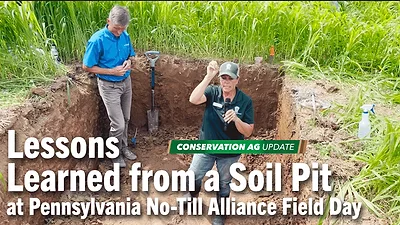Populations of European corn borer (ECB), a major corn crop pest, have declined significantly in the eastern United States, according to Penn State researchers. The decline suggests that the use of genetically modified, ECB-resistant corn hybrids - an expensive, yet effective, solution that has been widely adopted by farmers - may now be unnecessary in some areas.
A cornstalk broken due to larval feeding. Image: Eric Bohnenblust/Penn State
"ECB, which was introduced to North America from Europe in the 1900s, used to be the most important pest of corn in the United States," said John Tooker, assistant professor of entomology. "Not that long ago, it caused crop losses that annually approached $1 billion nationwide, and $35 million in the northeastern United States."
According to Tooker, to protect their crops from ECB, many farmers have grown a genetically modified type of corn that expresses insecticidal toxins that kill the worms. These toxins were isolated from the bacterium Bacillusthuringiensis (Bt).
"These Bt corn hybrids have been widely adopted because they are exceptional for managing ECB - 99.9 percent of larvae are expected to die when they feed on plants expressing Bt toxins," he said. "Yet a drawback to using these hybrids has been the high cost of purchasing the seeds, which can decrease potential profits."
To understand current ECB populations in Pennsylvania field corn, the researchers assessed larval damage in Bt and non-Bt corn hybrids at 29 sites over three years. Specifically, they planted Bt and non-Bt corn hybrids on farm sites across four growing zones in Pennsylvania in 2010, 2011 and 2012. During September of each season, they assessed corn borer damage on 400 random plants at each site. They sliced open stalks, and recorded the number of ECB tunnels and larvae per stalk. They also evaluated corn ears for ECB damage.
"Our results confirm that we are seeing widespread population declines of ECB in the East, similar to declines that have been found in the Midwestern United States," said Eric Bohnenblust, graduate student in entomology. "With less ECB damage around, non-Bt hybrids in our tests yielded just as well as Bt hybrids, so the decline in ECB populations provides an opportunity for growers to generate greater profits by planting high-yielding, non-Bt seed, which is much cheaper than Bt seed.
"Secondarily, planting more non-Bt corn will reduce the potential for ECB to develop resistance to Bt toxins as corn rootworms have done in about a dozen states so far."
The team's results appeared in an early online edition of the journal Pest Management Science in December.
In addition to investigating the extent of ECB populations and damage in Pennsylvania, the researchers also examined the predictive ability of the PestWatch network, which traps ECB and other moth species and provides data about their prevalence.
"While traps within the PestWatch network provide insight on ECB population size, where moths are active and periods of ECB activity, their utility as a predictive tool, particularly for field corn, has been limited," Bohnenblust said. "We found that ECB moths captured in the PestWatch network correlate well with in-field populations of ECB in field corn, which means that PestWatch data hold potential to inform decisions about whether Bt or non-Bt hybrids are right for growers in different parts of the state."
According to Tooker, growers planting Bt corn hybrids are required to plant set amounts of non-Bt corn as part of a resistance management plan to help prevent evolution of ECB populations that are resistant to the Bt toxins expressed in corn hybrids.
"Based on our results, we would tell growers to scout their non-Bt acreage toward the end of the growing season," he said. "If they have low ECB populations, and PestWatch reflects low moth captures in their area, we would recommend that in the next season they give competitive non-Bt hybrids a try on some of their acres because they could see better profits from growing non-Bt hybrids."
Other authors on the paper include James Breining and John Shaffer, research support assistants in plant science; Shelby Fleischer, professor of entomology; and Gregory Roth, professor of agronomy.





